No edit summary Tag: sourceedit |
Tag: sourceedit |
||
| (21 intermediate revisions by 10 users not shown) | |||
| Line 72: | Line 72: | ||
==Mechanics and specifications== |
==Mechanics and specifications== |
||
===Mechanics=== |
===Mechanics=== |
||
| − | [[File: |
+ | [[File:Lighsaberkylo.png|left|thumb|120px|The inner workings of [[Kylo Ren]]'s [[Kylo Ren's lightsaber|lightsaber]].]] |
Metal was usually chosen to make up the hilt, but a casing carved from the [[Brylark tree]], wood that is strong as metal, would also work.<ref name="ATOS">{{TCW|A Test of Strength}}</ref>. Some hilts were even crafted of gems.<ref name="Dark Disciple">''[[Dark Disciple]]''</ref> The weapon drew power from an appropriately-sized power cell.<ref name="Path of the Jedi">{{Rebels|Path of the Jedi}}</ref> Parts that will work to make a lightsaber include modulation circuits and an energy gate. Ones that are necessary include a blade emitter shroud, the emitter matrix and some type of activator to turn the weapon on and off. Other parts that could be added include handgrip ridges and a blade length adjuster.<ref name="Path of the Jedi" /><ref name="Visual Guide">''[[Star Wars Rebels: The Visual Guide]]''</ref> Some lightsabers also featured a non-lethal low-power setting used for training.<ref name="Chopper Base">{{Rebels|The Mystery of Chopper Base}}</ref> Single-bladed lightsabers usually had a belt ring so they could be hung from a belt hook, or a wheel-shaped attachment that slotted into a matching belt clip on the owner's belt when not in use.<ref name="Episode I" /><ref name="Episode II" /><ref name="Episode III">[[Star Wars: Episode III Revenge of the Sith|''Star Wars'': Episode III ''Revenge of the Sith'']]</ref><ref>[[Star Wars Rebels: Spark of Rebellion]]</ref><ref name="Path of the Jedi" /> |
Metal was usually chosen to make up the hilt, but a casing carved from the [[Brylark tree]], wood that is strong as metal, would also work.<ref name="ATOS">{{TCW|A Test of Strength}}</ref>. Some hilts were even crafted of gems.<ref name="Dark Disciple">''[[Dark Disciple]]''</ref> The weapon drew power from an appropriately-sized power cell.<ref name="Path of the Jedi">{{Rebels|Path of the Jedi}}</ref> Parts that will work to make a lightsaber include modulation circuits and an energy gate. Ones that are necessary include a blade emitter shroud, the emitter matrix and some type of activator to turn the weapon on and off. Other parts that could be added include handgrip ridges and a blade length adjuster.<ref name="Path of the Jedi" /><ref name="Visual Guide">''[[Star Wars Rebels: The Visual Guide]]''</ref> Some lightsabers also featured a non-lethal low-power setting used for training.<ref name="Chopper Base">{{Rebels|The Mystery of Chopper Base}}</ref> Single-bladed lightsabers usually had a belt ring so they could be hung from a belt hook, or a wheel-shaped attachment that slotted into a matching belt clip on the owner's belt when not in use.<ref name="Episode I" /><ref name="Episode II" /><ref name="Episode III">[[Star Wars: Episode III Revenge of the Sith|''Star Wars'': Episode III ''Revenge of the Sith'']]</ref><ref>[[Star Wars Rebels: Spark of Rebellion]]</ref><ref name="Path of the Jedi" /> |
||
| Line 82: | Line 82: | ||
===Cutting Power=== |
===Cutting Power=== |
||
| + | [[File:Jedi cutting door.png|thumb|250px|[[Qui-Gon Jinn]] using his lightsaber to cut through one of the ''[[Saak'ak]]''<nowiki>'</nowiki>s [[blast door]]s.]] |
||
| − | |||
A lightsaber blade was a mass-less form that neither radiated heat nor expended energy, other than that emitted as visible light, until it came into contact with something solid. The power of the energy blade was so great that it could cut through almost anything. One important note about lightsaber wounds is that they rarely bled profusely, even when a limb had been severed. This is because the energy blade cauterized the wound as it passed, and thus even a severe wound did not tend to bleed heavily. |
A lightsaber blade was a mass-less form that neither radiated heat nor expended energy, other than that emitted as visible light, until it came into contact with something solid. The power of the energy blade was so great that it could cut through almost anything. One important note about lightsaber wounds is that they rarely bled profusely, even when a limb had been severed. This is because the energy blade cauterized the wound as it passed, and thus even a severe wound did not tend to bleed heavily. |
||
| Line 93: | Line 93: | ||
'''Standard lightsaber''' |
'''Standard lightsaber''' |
||
:The standard lightsaber consisted of a straight hilt approximately 20 to 30 centimeters long. As it is the standard make, it has no defining features other than details on individual hilts, as each weapon is often self-fabricated by the wielder and customized to suit their specifications. |
:The standard lightsaber consisted of a straight hilt approximately 20 to 30 centimeters long. As it is the standard make, it has no defining features other than details on individual hilts, as each weapon is often self-fabricated by the wielder and customized to suit their specifications. |
||
| + | {{Clear}} |
||
[[File:Darth Maul's Lightsaber.jpg|thumb|right|150px|[[Darth Maul's double-bladed lightsaber]].]] |
[[File:Darth Maul's Lightsaber.jpg|thumb|right|150px|[[Darth Maul's double-bladed lightsaber]].]] |
||
| Line 98: | Line 99: | ||
{{Main|Double-bladed lightsaber}} |
{{Main|Double-bladed lightsaber}} |
||
:Also referred to as saberstaffs, double-bladed lightsabers consisted of a single hilt that projected a blade from both ends, resulting in a deadly staff-like weapon. Most saberstaff hilts were of increased length, as they usually consisted of two separate lightsabers connected at the pommels. |
:Also referred to as saberstaffs, double-bladed lightsabers consisted of a single hilt that projected a blade from both ends, resulting in a deadly staff-like weapon. Most saberstaff hilts were of increased length, as they usually consisted of two separate lightsabers connected at the pommels. |
||
| + | {{Clear}} |
||
| + | [[File:Grand inquisitor lightsaber.png|thumb|right|150px|[[The Grand Inquisitor|The Grand Inquisitor's]] [[Double-bladed spinning lightsaber|lightsaber]].]] |
||
'''Double-bladed spinning lightsaber''' |
'''Double-bladed spinning lightsaber''' |
||
{{Main|Double-bladed spinning lightsaber}} |
{{Main|Double-bladed spinning lightsaber}} |
||
:Similar to the saberstaff, these weapons could emit a blades from each end of the hilt. Unlike a saberstaff, however, the hilt was as long as a single-bladed lightsaber, with a circular rim that, when activated, could spin the baldes along a track. |
:Similar to the saberstaff, these weapons could emit a blades from each end of the hilt. Unlike a saberstaff, however, the hilt was as long as a single-bladed lightsaber, with a circular rim that, when activated, could spin the baldes along a track. |
||
| + | {{Clear}} |
||
| + | [[File:Kylo lightsaber hilt.png|thumb|right|175px|[[Kylo Ren's lightsaber]].]] |
||
'''Crossguard lightsaber''' |
'''Crossguard lightsaber''' |
||
{{Main|Crossguard lightsaber/Canon}} |
{{Main|Crossguard lightsaber/Canon}} |
||
| − | :An ancient design dating back to the [[Great Scourge of Malachor]], a |
+ | :An ancient design dating back to the [[Great Scourge of Malachor]], a crossguard lightsaber consisted of a standard blade with two shorter blades perpendicular to it at the end of the hilt. |
| + | {{Clear}} |
||
| − | [[File:DookuSaber-MR.jpg|thumb|right| |
+ | [[File:DookuSaber-MR.jpg|thumb|right|175px|[[Dooku's lightsaber|Darth Tyranus's curved-hilt lightsaber]].]] |
'''Curved-hilt lightsaber''' |
'''Curved-hilt lightsaber''' |
||
{{Main|Dooku's lightsaber}} |
{{Main|Dooku's lightsaber}} |
||
:Curved-hilt lightsabers were of a design which featured a hilt with a built in curve. This was usually done to allow the hilt to fit better into the palm, facilitating the use of one-handed fighting styles such as [[Form II]], or to provide variable blade angle to confuse opponents. |
:Curved-hilt lightsabers were of a design which featured a hilt with a built in curve. This was usually done to allow the hilt to fit better into the palm, facilitating the use of one-handed fighting styles such as [[Form II]], or to provide variable blade angle to confuse opponents. |
||
| + | {{Clear}} |
||
| + | [[File:Ezra lightsaber.png|thumb|right|120px|[[Ezra's lightsaber]].]] |
||
'''Lightsaber-blaster hybrid''' |
'''Lightsaber-blaster hybrid''' |
||
{{Main|Ezra's lightsaber}} |
{{Main|Ezra's lightsaber}} |
||
:Though only one example of this has been seen, it is essentially a single bladed lightsaber with an attachment that allows it to shoot blaster bolts. |
:Though only one example of this has been seen, it is essentially a single bladed lightsaber with an attachment that allows it to shoot blaster bolts. |
||
| + | {{Clear}} |
||
| + | [[File:Lightsaber pike canon.png|thumb|right|150px|[[Lightsaber pike|Jedi Temple Guard lightsaber pike]].]] |
||
'''Lightsaber pike''' |
'''Lightsaber pike''' |
||
{{Main|Lightsaber pike}} |
{{Main|Lightsaber pike}} |
||
:Resembling pole-arms in many respects, lightsaber pikes featured extremely long handles with somewhat shorter lightsaber blades. |
:Resembling pole-arms in many respects, lightsaber pikes featured extremely long handles with somewhat shorter lightsaber blades. |
||
| + | {{Clear}} |
||
| + | [[File:Maul lightsaber.png|thumb|right|120px|[[Maul's lightsaber]].]] |
||
'''Cane-disguised lightsaber''' |
'''Cane-disguised lightsaber''' |
||
| + | {{Main|Maul's lightsaber}} |
||
:The Cane disguised lightsaber was a simple variation of the standard lightsaber concealed as the head of a cane. In combat, the handle would be detached from the body of the cane and wielded normally. [[Tera Sinube]] wielded such a weapon, as did Darth Maul, though his was a saberstaff concealed in the head of a cane. |
:The Cane disguised lightsaber was a simple variation of the standard lightsaber concealed as the head of a cane. In combat, the handle would be detached from the body of the cane and wielded normally. [[Tera Sinube]] wielded such a weapon, as did Darth Maul, though his was a saberstaff concealed in the head of a cane. |
||
| + | {{Clear}} |
||
| − | [[File:Yoda teaching.png|thumb|right|200px|Jedi Initiates practice with training |
+ | [[File:Yoda teaching.png|thumb|right|200px|Jedi Initiates practice with [[training lightsaber]]s.]] |
'''Training lightsaber''' |
'''Training lightsaber''' |
||
{{Main|Training lightsaber}} |
{{Main|Training lightsaber}} |
||
:Training lightsabers were essentially regular lightsabers, only engineered with a permanent low-power setting, rather than the adjustable setting featured on standard weapons. As their name indicates, training lightsabers were used for instructional purposes, teaching initiates how to wield a lightsaber. |
:Training lightsabers were essentially regular lightsabers, only engineered with a permanent low-power setting, rather than the adjustable setting featured on standard weapons. As their name indicates, training lightsabers were used for instructional purposes, teaching initiates how to wield a lightsaber. |
||
| + | {{Clear}} |
||
| + | [[File:Yodas lightsaber Databank.jpeg|thumb|right|200px|[[Yoda's lightsaber]].]] |
||
'''Shoto''' |
'''Shoto''' |
||
{{Main|Shoto}} |
{{Main|Shoto}} |
||
| − | :Essentially, a shoto was a short lightsaber. Featuring a shortened blade length and diminutive handle, it was basically a miniaturized lightsaber. Shotos were usually used as the secondary weapon in [[Jar'Kai|dual-blade combat]]. Shotos were also used a primary weapons by some duelists, most who did so being of diminuative size, making a full sized lightsaber impractical, though this is not always the case. An |
+ | :Essentially, a shoto was a short lightsaber. Featuring a shortened blade length and diminutive handle, it was basically a miniaturized lightsaber. Shotos were usually used as the secondary weapon in [[Jar'Kai|dual-blade combat]]. Shotos were also used a primary weapons by some duelists, most who did so being of diminuative size, making a full sized lightsaber impractical, though this is not always the case. An example of this would be [[Yoda]]. |
| + | {{Clear}} |
||
| − | [[File:DarksaberRender.jpg|thumb|right|200px|The darksaber.]] |
+ | [[File:DarksaberRender.jpg|thumb|right|200px|[[Darksaber (lightsaber)|The darksaber]].]] |
'''Darksaber''' |
'''Darksaber''' |
||
{{Main|Darksaber (lightsaber)}} |
{{Main|Darksaber (lightsaber)}} |
||
:This ancient lightsaber had a unique black blade that was flattened and came to a point like a traditional sword, rather than the rounded beam of more standard lightsabers. |
:This ancient lightsaber had a unique black blade that was flattened and came to a point like a traditional sword, rather than the rounded beam of more standard lightsabers. |
||
| + | {{Clear}} |
||
==Usage and application== |
==Usage and application== |
||
===Combat=== |
===Combat=== |
||
| − | [[File:Makashi.jpg|thumb|200px| |
+ | [[File:Makashi.jpg|thumb|200px|left|Anakin Skywalker and [[Count]] [[Dooku]] engage in lightsaber combat.]] |
{{Main|Lightsaber combat}} |
{{Main|Lightsaber combat}} |
||
'''Lightsaber combat''' was the preferred fighting method used by lightsaber wielders. Throughout the millennia, many combat styles were refined into the seven "classic" forms that serve as the standard, and numerous other fighting methods that call for advanced levels of skill. Lightsaber combat was difficult to master for a number of reasons, one of them being a lightsaber built up momentum so quickly than an untrained wielder could lose control of the weapon. |
'''Lightsaber combat''' was the preferred fighting method used by lightsaber wielders. Throughout the millennia, many combat styles were refined into the seven "classic" forms that serve as the standard, and numerous other fighting methods that call for advanced levels of skill. Lightsaber combat was difficult to master for a number of reasons, one of them being a lightsaber built up momentum so quickly than an untrained wielder could lose control of the weapon. |
||
| Line 149: | Line 167: | ||
==Behind the scenes== |
==Behind the scenes== |
||
===Early concepts=== |
===Early concepts=== |
||
| − | [[File:ST Lightsaber.png|thumb| |
+ | [[File:ST Lightsaber.png|thumb|right|200px|Early concept art of lightsabers.]] |
The usage of the lightsaber was originally inspired by many of the serials that [[George Lucas]] watched and enjoyed as a child, which featured many characters wielding swords. When he began conceiving ''[[Star Wars]]'', he wished to include swords, creating the "lightsaber" to allow them to better mesh with the futuristic setting.<ref name="BotL">''[[The Birth of the Lightsaber]]''</ref> |
The usage of the lightsaber was originally inspired by many of the serials that [[George Lucas]] watched and enjoyed as a child, which featured many characters wielding swords. When he began conceiving ''[[Star Wars]]'', he wished to include swords, creating the "lightsaber" to allow them to better mesh with the futuristic setting.<ref name="BotL">''[[The Birth of the Lightsaber]]''</ref> |
||
| Line 157: | Line 175: | ||
===Prop design and effects=== |
===Prop design and effects=== |
||
| − | [[File:Graflex.jpg |
+ | [[File:Graflex.jpg|thumb|left|A Graflex flash similar to the one used for [[Luke Skywalker]]'s first lightsaber.]] |
During the filming of ''[[Star Wars: Episode IV A New Hope|A New Hope]]'', the [[Skywalker's lightsaber|Anakin/Luke lightsaber]] was made from a Graflex camera side-attach flash, while [[Darth Vader's lightsaber]] was made from a Micro Precision Products flash attachment. The handle grips were made with T-shaped pieces of plastic from sliding glass cabinet windows and, contrary to popular belief, were not made with rubber windshield wipers. D-rings were attached to the bottoms of the units so that they could be worn on belts. [[Obi-Wan Kenobi's third lightsaber|Obi-Wan Kenobi's lightsaber]] was the most complex hilt at the time. It was assembled from parts of an Armitage Shanks Starlite model Handwheel, Browning ANM2 machine gun booster, WWI No.3 Mk.1 British Rifle Grenade and a Rolls-Royce Derwent Mk.8/Mk.9 Jet Engine Balance Pipe. |
During the filming of ''[[Star Wars: Episode IV A New Hope|A New Hope]]'', the [[Skywalker's lightsaber|Anakin/Luke lightsaber]] was made from a Graflex camera side-attach flash, while [[Darth Vader's lightsaber]] was made from a Micro Precision Products flash attachment. The handle grips were made with T-shaped pieces of plastic from sliding glass cabinet windows and, contrary to popular belief, were not made with rubber windshield wipers. D-rings were attached to the bottoms of the units so that they could be worn on belts. [[Obi-Wan Kenobi's third lightsaber|Obi-Wan Kenobi's lightsaber]] was the most complex hilt at the time. It was assembled from parts of an Armitage Shanks Starlite model Handwheel, Browning ANM2 machine gun booster, WWI No.3 Mk.1 British Rifle Grenade and a Rolls-Royce Derwent Mk.8/Mk.9 Jet Engine Balance Pipe. |
||
The lightsaber effects during the [[Original trilogy|original trilogy]] started out in a very complicated manner. During the filming of ''A New Hope'', the blade was made of a three-sided rod covered with reflective material. The rod was then rapidly spun by a compact motor in the hilt, reflecting the lights on set and creating an in-camera glowing effect. However, these props were highly limited; they were cumbersome and fragile, often breaking during fight scenes. Also, the glowing effect was not absolute, as whenever the blade moved out of the light or pointed more directly at the camera the glow disappeared and the actual spinning rod could be seen. In order to partially compensate for this loss of the effect, the blade was rotoscoped and an animated glow was added by tracing onto a blown-up copy of the frame with pen and colored ink, one frame at a time. It was at this phase that blades were given colors, as the props were simple white blades.<ref name="BotL" /><ref name="Ldb" /> |
The lightsaber effects during the [[Original trilogy|original trilogy]] started out in a very complicated manner. During the filming of ''A New Hope'', the blade was made of a three-sided rod covered with reflective material. The rod was then rapidly spun by a compact motor in the hilt, reflecting the lights on set and creating an in-camera glowing effect. However, these props were highly limited; they were cumbersome and fragile, often breaking during fight scenes. Also, the glowing effect was not absolute, as whenever the blade moved out of the light or pointed more directly at the camera the glow disappeared and the actual spinning rod could be seen. In order to partially compensate for this loss of the effect, the blade was rotoscoped and an animated glow was added by tracing onto a blown-up copy of the frame with pen and colored ink, one frame at a time. It was at this phase that blades were given colors, as the props were simple white blades.<ref name="BotL" /><ref name="Ldb" /> |
||
| − | [[File:Lukevaderunrotoscoped.jpg|thumb| |
+ | [[File:Lukevaderunrotoscoped.jpg|thumb|right|[[Mark Hamill]] and [[Bob Anderson]] duel with carbon rods.]]During the filming of ''[[Star Wars: Episode V The Empire Strikes Back|The Empire Strikes Back]]'', it was decided creating an in-camera glowing effect was more trouble than it was worth, so the spinning rods were swapped for carbon rods. While these new blades were less cumbersome than before, they were still very fragile and frequently broke. However, they continued to be used for ''[[Star Wars: Episode VI Return of the Jedi|Return of the Jedi]]''.<ref name="BotL" /> |
When filming began for ''[[Star Wars: Episode I The Phantom Menace|The Phantom Menace]]'', the new lightsaber blades were steel and aluminum rods, which were highly durable, but frequently bent and flexed, requiring constant replacement.<ref name="TLA">{{SWArchive|url=episode-i/bts/production/news19980409.html|text=The Lightsaber Armory}}</ref> Despite such a drawback, these rods still saw usage during the filming of ''[[Star Wars: Episode II Attack of the Clones|Attack of the Clones]]'', as they had no alternative at the time. However, for the filming of ''[[Star Wars: Episode III Revenge of the Sith|Revenge of the Sith]]'', the blades were replaced by carbon fiber rods laminated with glass and plastic. These new props were highly durable and didn't flex, though they were extremely hard, often causing bruising and leaving scars. While lightsaber effects were still done by rotoscoping for the [[Prequel trilogy|prequels]], they were done digitally, rather than by hand.<ref name="Ldb" /> |
When filming began for ''[[Star Wars: Episode I The Phantom Menace|The Phantom Menace]]'', the new lightsaber blades were steel and aluminum rods, which were highly durable, but frequently bent and flexed, requiring constant replacement.<ref name="TLA">{{SWArchive|url=episode-i/bts/production/news19980409.html|text=The Lightsaber Armory}}</ref> Despite such a drawback, these rods still saw usage during the filming of ''[[Star Wars: Episode II Attack of the Clones|Attack of the Clones]]'', as they had no alternative at the time. However, for the filming of ''[[Star Wars: Episode III Revenge of the Sith|Revenge of the Sith]]'', the blades were replaced by carbon fiber rods laminated with glass and plastic. These new props were highly durable and didn't flex, though they were extremely hard, often causing bruising and leaving scars. While lightsaber effects were still done by rotoscoping for the [[Prequel trilogy|prequels]], they were done digitally, rather than by hand.<ref name="Ldb" /> |
||
| Line 174: | Line 192: | ||
===Choreography=== |
===Choreography=== |
||
| − | [[File:Theed duel stunts 1.jpg| |
+ | [[File:Theed duel stunts 1.jpg|left|thumb|200px|[[Ray Park]] practices dueling with the stunt doubles of [[Liam Neeson]] and [[Ewan McGregor]].]] |
While the usage of lightsabers was originally inspired by rapiers featured in the old serials George Lucas enjoyed, the final choreography in ''A New Hope'' looked nothing like fencing. As Jedi and their Sith counterparts were heavily inspired by [[Wikipedia:Samurai|samurai]], the fighting styles utilized were based more on [[Wikipedia:Kendo|kendo]].<ref name="EoD">''[[Empire of Dreams]]''</ref> The slower, more strength-oriented moves of kendo used in the duel also helped mesh with Lucas' concept that it was a battle between what were essentially two old men.<ref name="BotL" /> |
While the usage of lightsabers was originally inspired by rapiers featured in the old serials George Lucas enjoyed, the final choreography in ''A New Hope'' looked nothing like fencing. As Jedi and their Sith counterparts were heavily inspired by [[Wikipedia:Samurai|samurai]], the fighting styles utilized were based more on [[Wikipedia:Kendo|kendo]].<ref name="EoD">''[[Empire of Dreams]]''</ref> The slower, more strength-oriented moves of kendo used in the duel also helped mesh with Lucas' concept that it was a battle between what were essentially two old men.<ref name="BotL" /> |
||
| Line 321: | Line 339: | ||
*''[[Tarkin (novel)|Tarkin]]'' |
*''[[Tarkin (novel)|Tarkin]]'' |
||
*''[[A New Dawn]]'' |
*''[[A New Dawn]]'' |
||
| + | *''[[Lost Stars]]'' {{Mo}} |
||
*''[[Star Wars 7: From the Journals of Old Ben Kenobi: The Last of His Breed|Star Wars 7: From the Journals of Old Ben Kenobi: "The Last of His Breed"]]'' |
*''[[Star Wars 7: From the Journals of Old Ben Kenobi: The Last of His Breed|Star Wars 7: From the Journals of Old Ben Kenobi: "The Last of His Breed"]]'' |
||
*''[[Star Wars 15: From the Journals of Old Ben Kenobi]]'' |
*''[[Star Wars 15: From the Journals of Old Ben Kenobi]]'' |
||
| + | *''[[Star Wars 20 (Marvel)|Star Wars 20]]'' |
||
*''[[Star Wars Rebels: Spark of Rebellion]]'' |
*''[[Star Wars Rebels: Spark of Rebellion]]'' |
||
*''[[The Rebellion Begins]]'' |
*''[[The Rebellion Begins]]'' |
||
| Line 342: | Line 362: | ||
*''[[A New Hero]]'' |
*''[[A New Hero]]'' |
||
*''[[Star Wars Rebels: Rebel Strike]]'' |
*''[[Star Wars Rebels: Rebel Strike]]'' |
||
| + | *''[[Star Wars: Kanan 6: The Last Padawan, Epilogue: Haunt]]'' |
||
| + | *''[[Star Wars: Kanan 12: First Blood, Epilogue: The Ties That Bind]]'' |
||
*''[[Star Wars Rebels: The Siege of Lothal]]'' |
*''[[Star Wars Rebels: The Siege of Lothal]]'' |
||
*{{Rebels|The Lost Commanders}} |
*{{Rebels|The Lost Commanders}} |
||
| Line 389: | Line 411: | ||
*''[[Epic Yarns: The Empire Strikes Back]]'' {{Nc}} |
*''[[Epic Yarns: The Empire Strikes Back]]'' {{Nc}} |
||
*''[[The Empire Strikes Back: So You Want to Be a Jedi?]]'' |
*''[[The Empire Strikes Back: So You Want to Be a Jedi?]]'' |
||
| + | *''[[Moving Target: A Princess Leia Adventure]]'' {{Mo}} |
||
*[[Star Wars: Episode VI Return of the Jedi|''Star Wars'': Episode VI ''Return of the Jedi'']] |
*[[Star Wars: Episode VI Return of the Jedi|''Star Wars'': Episode VI ''Return of the Jedi'']] |
||
*''[[Episode VI: Return of the Jedi Read-Along Storybook and CD]]'' |
*''[[Episode VI: Return of the Jedi Read-Along Storybook and CD]]'' |
||
Revision as of 01:45, 30 April 2016
| | |
Warning: The following parameters in the infobox are unrecognized: color, era, imageBG
- "This is the weapon of a Jedi Knight. Not as clumsy or random as a blaster. An elegant weapon for a more civilized age."
- ―Obi-Wan Kenobi
The lightsaber, sometimes referred to as a laser sword, was a weapon used by the Jedi and the Sith.[16] Lightsabers consisted of a plasma blade, powered by a kyber crystal[17] and usually emitted from a metallic hilt.[5] It was a weapon that required skill and training, and was greatly enhanced when used in conjunction with the Force. Though also used by the Sith, the lightsaber was synonymous with the Jedi,[18] with some in the galaxy believing only Jedi used lightsabers.[16]
Lightsabers were generally used both for combat and defense. A lightsaber could cut through virtually anything, from enemies to blast doors.[13] The only ways to block the incoming attack of a lightsaber was with a weapon made with material that conducts energy such as an electrostaff[19] or Z6 riot control baton,[20] or another lightsaber.[5] When used defensively, a skilled user could deflect blaster bolts with a lightsaber, and even reflect the shots back toward the shooter or some other target.[13] Experienced Jedi could even employ their lightsabers to absorb Force lightning.[9] Most practitioners used one single-bladed lightsaber, though some used double-bladed lightsabers[16] or even multiple lightsabers at once.[9]
Lightsaber combat was divided into several Forms; Form I, Form II, Form III, Form IV, Form V, Form VI and Form VII.
By approximately thirty years after the death of the Galactic Emperor, Darth Sidious,[21] Kylo Ren wielded a red crossguard lightsaber that extended with two miniature blades.[22]
History
Though it is unknown when the first lightsaber was created, it is known they were in use thousands of years before the First Order-Resistance conflict, in the Great Scourge of Malachor. They were also used in the Battles of Rashfond and the Peacekeeping of Parliock.
Lightsabers took on a more prominent role in galactic affairs as the Clone Wars came to pass. Jedi, previously peacekeepers, became Jedi Generals of the Grand Army of the Republic, and thus began using their lightsabers more often than they had in their role of peacekeeping.
As the Clone Wars ended, and the Jedi Purge took place, lightsabers became a rarity in the galaxy, as the Jedi who once used them were greatly reduced in number and did not use their weapons as often for fear of drawing attention. For the majority of the reign of the Empire, the only lightsaber that was prominently used was that of Darth Vader, and, in its waning years, that of Luke Skywalker.
After the Empire was defeated, Luke began training a new generation of Jedi. These, however, were massacred by Kylo Ren and the Knights of Ren, once again leading to a time where the only prominent lightsaber user was a darksider.
Mechanics and specifications
Mechanics
The inner workings of Kylo Ren's lightsaber.
Metal was usually chosen to make up the hilt, but a casing carved from the Brylark tree, wood that is strong as metal, would also work.[23]. Some hilts were even crafted of gems.[24] The weapon drew power from an appropriately-sized power cell.[25] Parts that will work to make a lightsaber include modulation circuits and an energy gate. Ones that are necessary include a blade emitter shroud, the emitter matrix and some type of activator to turn the weapon on and off. Other parts that could be added include handgrip ridges and a blade length adjuster.[25][26] Some lightsabers also featured a non-lethal low-power setting used for training.[27] Single-bladed lightsabers usually had a belt ring so they could be hung from a belt hook, or a wheel-shaped attachment that slotted into a matching belt clip on the owner's belt when not in use.[16][9][28][29][25]
During assembly, it was important to not accidentally invert the emitter matrix; when improperly activated the lightsaber's power grid would backfire. At best this could cause the blade to quickly short out, but if left on the faulty weapon would violently explode, potentially killing those in close proximity.[23]
Specially designed lightsabers could even use unstable crystals, such as Kylo Ren's lightsaber, which featured two laterally facing vents designed to divert excess energy away from the cracked crystal and keep the lightsaber stable.[30]
On the aquatic planet of Mon Calamari, the Jedi Kit Fisto, Obi-Wan Kenobi, Anakin Skywalker and Ahsoka Tano were all able to use their lightsabers underwater with no ill effects, although whether this was a standard feature of the weapon or a later adjustment is unknown. Whilst in areas of low light, a lightsaber could easily function as a light source, demonstrated by Jedi Master Yoda and Sith Lord Savage Opress.
Cutting Power
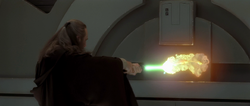
Qui-Gon Jinn using his lightsaber to cut through one of the Saak'ak's blast doors.
A lightsaber blade was a mass-less form that neither radiated heat nor expended energy, other than that emitted as visible light, until it came into contact with something solid. The power of the energy blade was so great that it could cut through almost anything. One important note about lightsaber wounds is that they rarely bled profusely, even when a limb had been severed. This is because the energy blade cauterized the wound as it passed, and thus even a severe wound did not tend to bleed heavily.
Lightsaber-resistant materials
Aside from the blade of another lightsaber, there were rare materials that could withstand a lightsaber blade:
- Zillo Beast hide could deflect lightsaber strikes, but because the beasts are extinct, this material is exceedingly rare.
Variations
Qui-Gon Jinn's standard-hilted lightsaber.
Standard lightsaber
- The standard lightsaber consisted of a straight hilt approximately 20 to 30 centimeters long. As it is the standard make, it has no defining features other than details on individual hilts, as each weapon is often self-fabricated by the wielder and customized to suit their specifications.
Double-bladed lightsaber
- Also referred to as saberstaffs, double-bladed lightsabers consisted of a single hilt that projected a blade from both ends, resulting in a deadly staff-like weapon. Most saberstaff hilts were of increased length, as they usually consisted of two separate lightsabers connected at the pommels.

Double-bladed spinning lightsaber
- Similar to the saberstaff, these weapons could emit a blades from each end of the hilt. Unlike a saberstaff, however, the hilt was as long as a single-bladed lightsaber, with a circular rim that, when activated, could spin the baldes along a track.
Crossguard lightsaber
- An ancient design dating back to the Great Scourge of Malachor, a crossguard lightsaber consisted of a standard blade with two shorter blades perpendicular to it at the end of the hilt.

Curved-hilt lightsaber
- Curved-hilt lightsabers were of a design which featured a hilt with a built in curve. This was usually done to allow the hilt to fit better into the palm, facilitating the use of one-handed fighting styles such as Form II, or to provide variable blade angle to confuse opponents.

Lightsaber-blaster hybrid
- Though only one example of this has been seen, it is essentially a single bladed lightsaber with an attachment that allows it to shoot blaster bolts.

Lightsaber pike
- Resembling pole-arms in many respects, lightsaber pikes featured extremely long handles with somewhat shorter lightsaber blades.
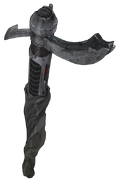
Cane-disguised lightsaber
- The Cane disguised lightsaber was a simple variation of the standard lightsaber concealed as the head of a cane. In combat, the handle would be detached from the body of the cane and wielded normally. Tera Sinube wielded such a weapon, as did Darth Maul, though his was a saberstaff concealed in the head of a cane.

Jedi Initiates practice with training lightsabers.
Training lightsaber
- Training lightsabers were essentially regular lightsabers, only engineered with a permanent low-power setting, rather than the adjustable setting featured on standard weapons. As their name indicates, training lightsabers were used for instructional purposes, teaching initiates how to wield a lightsaber.
Shoto
- Essentially, a shoto was a short lightsaber. Featuring a shortened blade length and diminutive handle, it was basically a miniaturized lightsaber. Shotos were usually used as the secondary weapon in dual-blade combat. Shotos were also used a primary weapons by some duelists, most who did so being of diminuative size, making a full sized lightsaber impractical, though this is not always the case. An example of this would be Yoda.

The darksaber.
Darksaber
- This ancient lightsaber had a unique black blade that was flattened and came to a point like a traditional sword, rather than the rounded beam of more standard lightsabers.
Usage and application
Combat
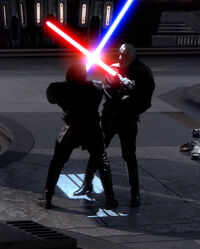
Anakin Skywalker and Count Dooku engage in lightsaber combat.
Lightsaber combat was the preferred fighting method used by lightsaber wielders. Throughout the millennia, many combat styles were refined into the seven "classic" forms that serve as the standard, and numerous other fighting methods that call for advanced levels of skill. Lightsaber combat was difficult to master for a number of reasons, one of them being a lightsaber built up momentum so quickly than an untrained wielder could lose control of the weapon.
Rituals
Knighting ceremony Lightsabers were an integral part of the knighting ceremonies of the Jedi Order. During the ceremony, a Padawan would have his or her Padawan braid ritualistically severed by the presiding Jedi Master. The Master would then motion the blade on each of the Padawan's shoulders(as actually touching the blade to the shouder would cause injury) and say "By the right of the Council, by the will of the Force, [Insert Padawan's name here], you may rise".
Behind the scenes
Early concepts
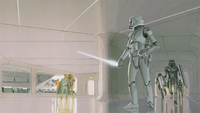
Early concept art of lightsabers.
The usage of the lightsaber was originally inspired by many of the serials that George Lucas watched and enjoyed as a child, which featured many characters wielding swords. When he began conceiving Star Wars, he wished to include swords, creating the "lightsaber" to allow them to better mesh with the futuristic setting.[31]
In the early incarnations of the Star Wars storyline, lightsabers were not exclusive to the Jedi and other Force-users, but were in fact very mundane. Early concept art depicts lightsabers being wielded by Rebel and Imperial soldiers alike. George Lucas later limited the lightsabers to exclusively the Jedi in order to make them feel more unusual, and heighten the mystique of the Jedi.[32] Also, in early drafts of the script, lightsabers were referred to as "lazerswords."
Crystals first appear in Star Wars simply as an embedded decoration on the hilt in the original film's novelization. Aside from this single instance, there are no crystals mentioned in any of the movies or their novelizations.[33]
Prop design and effects
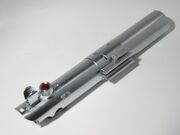
A Graflex flash similar to the one used for Luke Skywalker's first lightsaber.
During the filming of A New Hope, the Anakin/Luke lightsaber was made from a Graflex camera side-attach flash, while Darth Vader's lightsaber was made from a Micro Precision Products flash attachment. The handle grips were made with T-shaped pieces of plastic from sliding glass cabinet windows and, contrary to popular belief, were not made with rubber windshield wipers. D-rings were attached to the bottoms of the units so that they could be worn on belts. Obi-Wan Kenobi's lightsaber was the most complex hilt at the time. It was assembled from parts of an Armitage Shanks Starlite model Handwheel, Browning ANM2 machine gun booster, WWI No.3 Mk.1 British Rifle Grenade and a Rolls-Royce Derwent Mk.8/Mk.9 Jet Engine Balance Pipe.
The lightsaber effects during the original trilogy started out in a very complicated manner. During the filming of A New Hope, the blade was made of a three-sided rod covered with reflective material. The rod was then rapidly spun by a compact motor in the hilt, reflecting the lights on set and creating an in-camera glowing effect. However, these props were highly limited; they were cumbersome and fragile, often breaking during fight scenes. Also, the glowing effect was not absolute, as whenever the blade moved out of the light or pointed more directly at the camera the glow disappeared and the actual spinning rod could be seen. In order to partially compensate for this loss of the effect, the blade was rotoscoped and an animated glow was added by tracing onto a blown-up copy of the frame with pen and colored ink, one frame at a time. It was at this phase that blades were given colors, as the props were simple white blades.[31][32]
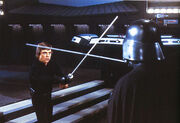
Mark Hamill and Bob Anderson duel with carbon rods.
During the filming of The Empire Strikes Back, it was decided creating an in-camera glowing effect was more trouble than it was worth, so the spinning rods were swapped for carbon rods. While these new blades were less cumbersome than before, they were still very fragile and frequently broke. However, they continued to be used for Return of the Jedi.[31]
When filming began for The Phantom Menace, the new lightsaber blades were steel and aluminum rods, which were highly durable, but frequently bent and flexed, requiring constant replacement.[34] Despite such a drawback, these rods still saw usage during the filming of Attack of the Clones, as they had no alternative at the time. However, for the filming of Revenge of the Sith, the blades were replaced by carbon fiber rods laminated with glass and plastic. These new props were highly durable and didn't flex, though they were extremely hard, often causing bruising and leaving scars. While lightsaber effects were still done by rotoscoping for the prequels, they were done digitally, rather than by hand.[32]
For The Force Awakens, the lightsaber props glowed, using a similar effect used in Attack of the Clones during the fight between Anakin Skywalker and Count Dooku. In behind the scenes footage, it was revealed that the actors were using blades similar to the ones made by Master Replicas. This not only added to the environmental realism that was desired, but also immersed the actors in the lightsaber experience, building on the performance and convincing nature of the lightsaber effect.[35]
Colors
Lightsabers depicted in the first two released films, A New Hope and The Empire Strikes Back, had blades that were colored either blue (for the Jedi) or red (for the Sith). This color difference was a decision during post-production when the lightsaber blades were being rotoscoped, as the original blades were simply white. In Return of the Jedi, Luke Skywalker's newly-constructed lightsaber was colored blue during the initial editing of the film, and appears so in both an early movie trailer and the official theatrical posters, but in the final film, it was ultimately colored green in order to better stand out against the blue sky of Tatooine in outdoor scenes. It also appeared as green in re-release posters.
Both green and blue became standard blade colors for Jedi lightsabers in the Star Wars prequel trilogy. In the same regard, red became the standard Sith lightsaber. Mace Windu's purple lightsaber, as first seen in Attack of the Clones, was a personal request from actor Samuel L. Jackson as a way to make his character stand out among other Jedi. Jackson's favorite color is purple and he frequently requests the characters he plays to use an item of the color in his movies. In addition, there are yellow, white (like Ahsoka Tano's dual lightsabers) and black, with the latter two being the rarest in the series thus far.
Choreography
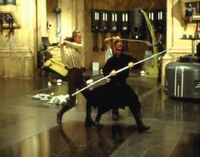
Ray Park practices dueling with the stunt doubles of Liam Neeson and Ewan McGregor.
While the usage of lightsabers was originally inspired by rapiers featured in the old serials George Lucas enjoyed, the final choreography in A New Hope looked nothing like fencing. As Jedi and their Sith counterparts were heavily inspired by samurai, the fighting styles utilized were based more on kendo.[36] The slower, more strength-oriented moves of kendo used in the duel also helped mesh with Lucas' concept that it was a battle between what were essentially two old men.[31]
During the filming of The Empire Strikes Back, Lucas began ramping up the speed of the duels, making them "faster and more intense," the idea being that Luke Skywalker was becoming increasingly proficient with the weapon.[31] Also, rather than utilize David Prowse, the actor within the Darth Vader costume, for the duels, they instead had professional swordsman Bob Anderson perform the fights, due to Prowse's tendency to repeatedly break the fragile prop blades. Anderson continued to serve as Prowse's fighting double during the filming of Return of the Jedi.
When filming began for The Phantom Menace, the new stunt coordinator Nick Gillard ramped up the speed and agility the characters demonstrated in lightsaber duels, the idea being that the prequels took place when the Jedi Order was in "full flower," at least in terms of combat techniques.[31] Gillard was careful to avoid giving the fight scenes a choreographed look, drawing upon his extensive knowledge of martial arts to create the moves.[37] The end result was a very fast-paced style of fighting, which he described as being like a chess game between grand masters, with every move being a check. This style of choreography was continued on throughout the prequel trilogy.[37]
In the choreography, the actors had to know how to fence so they could excel in the lightsaber duels. In Star Wars The Force Awakens, actors such as John Boyega who played FN-2187 had to do fighting and fencing. On NECN sports they showed the behind the scenes on the new Star Wars movie.
